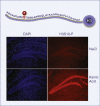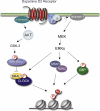Decoding the epigenetic language of neuronal plasticity
- PMID: 19109904
- PMCID: PMC2737473
- DOI: 10.1016/j.neuron.2008.10.012
Decoding the epigenetic language of neuronal plasticity
Abstract
Neurons are submitted to an exceptional variety of stimuli and are able to convert these into high-order functions, such as storing memories, controlling behavior, and governing consciousness. These unique properties are based on the highly flexible nature of neurons, a characteristic that can be regulated by the complex molecular machinery that controls gene expression. Epigenetic control, which largely involves events of chromatin remodeling, appears to be one way in which transcriptional regulation of gene expression can be modified in neurons. This review will focus on how epigenetic control in the mature nervous system may guide dynamic plasticity processes and long-lasting cellular neuronal responses. We outline the molecular pathways underlying chromatin transitions, propose the presence of an "epigenetic indexing code," and discuss how central findings accumulating at an exponential pace in the field of epigenetics are conceptually changing our perspective of adult brain function.
Figures







Similar articles
-
The circadian clock transcriptional complex: metabolic feedback intersects with epigenetic control.Ann N Y Acad Sci. 2012 Aug;1264(1):103-9. doi: 10.1111/j.1749-6632.2012.06649.x. Epub 2012 Jul 26. Ann N Y Acad Sci. 2012. PMID: 22834651 Free PMC article. Review.
-
Plasticity and specificity of the circadian epigenome.Nat Neurosci. 2010 Nov;13(11):1324-9. doi: 10.1038/nn.2668. Nat Neurosci. 2010. PMID: 20975756 Free PMC article.
-
Chromatin remodeling and neuronal function: exciting links.Genes Brain Behav. 2006;5 Suppl 2:80-91. doi: 10.1111/j.1601-183X.2006.00227.x. Genes Brain Behav. 2006. PMID: 16681803 Review.
-
Epigenetic marking and neuronal plasticity.Biol Psychiatry. 2007 Jul 1;62(1):1-3. doi: 10.1016/j.biopsych.2007.04.037. Biol Psychiatry. 2007. PMID: 17572174 Review. No abstract available.
-
Epigenetic mechanisms in mood disorders: targeting neuroplasticity.Neuroscience. 2014 Apr 4;264:112-30. doi: 10.1016/j.neuroscience.2013.01.041. Epub 2013 Jan 30. Neuroscience. 2014. PMID: 23376737 Free PMC article. Review.
Cited by
-
Oxaliplatin-Induced Neuropathy: Genetic and Epigenetic Profile to Better Understand How to Ameliorate This Side Effect.Front Mol Biosci. 2021 May 7;8:643824. doi: 10.3389/fmolb.2021.643824. eCollection 2021. Front Mol Biosci. 2021. PMID: 34026827 Free PMC article. Review.
-
A Functional Switch of NuRD Chromatin Remodeling Complex Subunits Regulates Mouse Cortical Development.Cell Rep. 2016 Nov 1;17(6):1683-1698. doi: 10.1016/j.celrep.2016.10.022. Cell Rep. 2016. PMID: 27806305 Free PMC article.
-
The circadian clock transcriptional complex: metabolic feedback intersects with epigenetic control.Ann N Y Acad Sci. 2012 Aug;1264(1):103-9. doi: 10.1111/j.1749-6632.2012.06649.x. Epub 2012 Jul 26. Ann N Y Acad Sci. 2012. PMID: 22834651 Free PMC article. Review.
-
Regulation of hippocampal H3 histone methylation by acute and chronic stress.Proc Natl Acad Sci U S A. 2009 Dec 8;106(49):20912-7. doi: 10.1073/pnas.0911143106. Epub 2009 Nov 23. Proc Natl Acad Sci U S A. 2009. PMID: 19934035 Free PMC article.
-
dTip60 HAT activity controls synaptic bouton expansion at the Drosophila neuromuscular junction.PLoS One. 2011;6(10):e26202. doi: 10.1371/journal.pone.0026202. Epub 2011 Oct 27. PLoS One. 2011. PMID: 22046262 Free PMC article.
References
-
- Alarcon JM, Malleret G, Touzani K, Vronskaya S, Ishii S, Kandel ER, Barco A. Chromatin acetylation, memory, and LTP are impaired in CBP+/ mice: a model for the cognitive deficit in Rubinstein-Taybi syndrome and its amelioration. Neuron. 2004;42:947–959. - PubMed
-
- Allis CD, Jenuwein T, Reinberg D, Caparros ML. Epigenetics. Cold Spring Harbor Laboratory Press; New York: 2007a.
-
- Allis CD, Berger SL, Cote J, Dent S, Jenuwien T, Kouzarides T, Pillus L, Reinberg D, Shi Y, Shiekhattar R, et al. New nomenclature for chromatin modifying enzymes. Cell. 2007b;131:633–636. - PubMed
-
- Amir RE, Van den Veyver IB, Wan M, Tran CQ, Francke U, Zoghbi HY. Rett syndrome is caused by mutations in X-linked MECP2, encoding methyl-CpG-binding protein 2. Nat. Genet. 1999;23:185–188. - PubMed
-
- Asher G, Garfield D, Stratman M, Reinke H, Dibner C, Kreppel F, Mostoslavsky R, Alt FW, Schibler U. SIRT1 regulates circadian clock gene expression through Per2 deacetylation. Cell. 2008;134:317–328. - PubMed
Publication types
MeSH terms
Grants and funding
- R01 MH051399-18/MH/NIMH NIH HHS/United States
- R01 DA007359/DA/NIDA NIH HHS/United States
- R01 DA007359-20/DA/NIDA NIH HHS/United States
- P01 DA008227/DA/NIDA NIH HHS/United States
- P50 MH066172/MH/NIMH NIH HHS/United States
- P01 DA008227-17/DA/NIDA NIH HHS/United States
- P01 DA008227-170003/DA/NIDA NIH HHS/United States
- R01 MH051399/MH/NIMH NIH HHS/United States
- P01 DA008227-16/DA/NIDA NIH HHS/United States
- R01 DA007359-21/DA/NIDA NIH HHS/United States
- P50 MH066172-069003/MH/NIMH NIH HHS/United States
- P50 MH066172-079003/MH/NIMH NIH HHS/United States
LinkOut - more resources
Full Text Sources
Other Literature Sources

